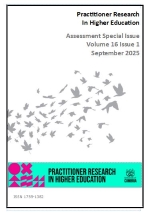Inclusive pedagogical and assessment practices for visually impaired students: Shifting from a deficit to an asset based approach
##plugins.themes.bootstrap3.article.main##
Abstract
This paper examines inclusive pedagogical and assessment practices for visually impaired students, advocating a shift from a deficit to an asset-based approach. Through narrative inquiry and literature analysis, the barriers faced by students with visual disabilities and lecturers, as well as implementation challenges and emerging best practices in South African higher education institutions, are explored. Despite progressive policy frameworks, significant gaps exist between policy intentions and classroom realities, leaving students and lecturers marginalised, with staff often feeling overwhelmed and incapacitated, and students feeling vulnerable, excluded, and disempowered in the educational process. The research reveals how traditional deficit-focused accommodations have inadvertently reinforced exclusion rather than promoting inclusion. Calling for an asset-based humanised approach that recognises students with visual disabilities as valuable contributors to educational environments rather than ‘problems requiring fixing’. This transformative approach necessitates reimagining pedagogical practices, assessment methods, and institutional support systems to harness technological innovations while centring visually impaired students’ diverse capabilities and knowledge contributions.
##plugins.themes.bootstrap3.article.details##
Proposed Policy for Journals That Offer Delayed Open Access
Authors who publish with this journal agree to the following terms:
- Authors retain copyright and grant the journal right of first publication, with the work for one year after publication simultaneously licensed under a Creative Commons Attribution License that allows others to share the work with an acknowledgement of the work's authorship and initial publication in this journal.
- Authors are able to enter into separate, additional contractual arrangements for the non-exclusive distribution of the journal's published version of the work (e.g., post it to an institutional repository or publish it in a book), with an acknowledgement of its initial publication in this journal.
- Authors are permitted and encouraged to post their work online (e.g., in institutional repositories or on their website) prior to and during the submission process, as it can lead to productive exchanges, as well as earlier and greater citation of published work (See The Effect of Open Access).

